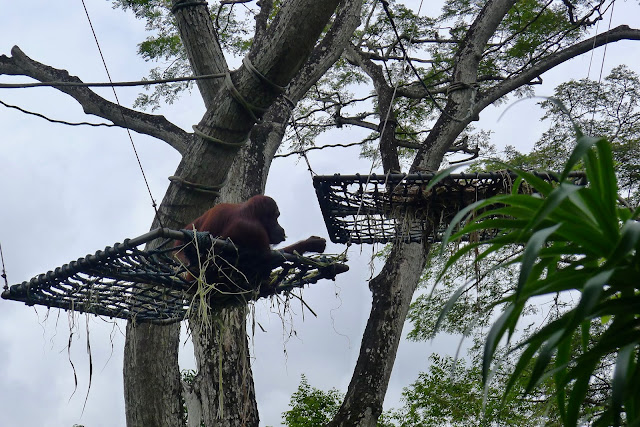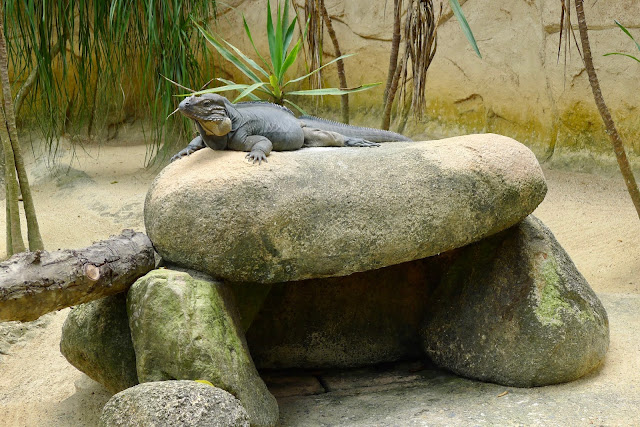Finally, we were able to visit the Singapore Zoo and River Safari during our last trip. We always wanted to go, but somehow, each trip becomes a mix of Sentosa Island attractions, food explorations, Ikea day and shopping. Our trip this year didn't include a trip to Sentosa Island. We have always gone each visit, and honestly, we can miss it for this one. So, here we are at the Singapore zoo.
We just took a TNVS ride to get here, it is quite a drive from where our hotel at Robertson Quay. In fact, we passed Singapore Changi airport as well. As we arrived near the area where the zoo is, we are greeted by lush vegetation, and it is a welcome sight. Singapore Zoo has over 2,800 animals inhabiting the lush tropical rainforest.
Cute signs that show you what's ahead.
These are estuarine crocodiles, they have guts of steel. These crocs don't have big stomachs and after having their fill, they may stow any leftovers in mangroves or underwater for another day. Large amounts of stomach acid help them break down their meals - even bones can be dissolved. To aid their digestion, they also swallow and store stones in their guts that help grind up their food.
After the dinosaurs disappeared, huge animals known as megafauna roamed the earth. While many of them were wiped out in a mass extinction, some of their descendants remain with us today.
The Malayan Tapir has a dramatic coat pattern, often referred to as "the saddle" pattern because of its position and shape. The front half of their body and hind legs are black, while the sides are white. This breaks up its outline and creates an illusive vision of a boulder.
I marveled at the white tiger for a long time, it is beautiful. White tigers are not albinos or a different sub-species of tigers. Their white coat, brown stripes and blue eyes are the result of a mutated gene. Being a recessive gene, its effects will only surface if a tiger received two copies of the gene - one each from its parents.
I love the smile on this turtle.
The pygmy hippo can't swim and it's body is too dense to float. It tiptoes along riverbeds gracefully like an underwater ballerina. To breathe, it uses its hind legs to push itself up above the water surface.
This is a Tree Kangaroo. Tree kangaroos are the only kangaroos that do not hop. Instead, they climb trees by moving their feet independently.
These are Eastern Grey Kangaroos, one of the largest kangaroo species. It swims well and dives into rivers to escape from predators like dingoes. If pursued, it turns on the dingo, holding it underwater until it drowns.
Majestic Asian Elephants. They live for about 60-70 years.
Orangutans are apes, which means that unlike monkeys, they do not have a tail. Found in the rainforests of Borneo and Sumatra, they have special feet with long toes for grasping branches, and long limbs that can stretch out far so that they can move easily through the treetops.
A huge animal that feeds exclusively on grass, the white rhino has a wide mouth shapes for 'mowing' short grass. its square lips set it apart from the hook-lipped black rhino.
A cheetah has a supple spine, long limbs, protruding claws and the ridges on its footpads aid the cheetah in achieving a top speed of up to 115km/h. It can keep this up for all of 20 seconds and no more than 400m, so it approaches to within 30m of its quarry before its final attack. When it gets within striking distance, it trips its prey over with a sideways stroke of its forepaw or it brings it down from the rear using its dewclaw (extra sharp claw on the side of the foreleg).
Though none have been proven conclusively, several theories attempt to explain the zebra's stripes. The first states that stripes have an anti-predatory function be creating an "optical illusion". The second points to a social role - each zebra is identifiable by its stripes and zebras with broader stripes receive more grooming. The third suggests the stripes help in thermoregulation and work as natural sunscreen. The last says may protect against tsetse flies.
Meerkat
This is a Red River Hog. Like other wild pigs, the red river hog uses its snout to root tubers. It can cause damage to crops when farmland encroaches on its habitat.
The giraffes at the Singapore zoo are fed Australian hay and leaves from local starfruit. Bunches of leaves are hoisted high up in the trees to encourage the giraffes to display their natural behavior of feeding off the highest leaves. They also take vegetables like carrots. Salt lick blocks supplement their diet with necessary minerals. In the wild, giraffes would eat soil rich in salt and other minerals.
Lions live in social groups known as prides, made of one or more mature males, several closely-related females and their young. Males roar and spray urine to advertise their territory to rivals. Females work in teams to take down prey, encircling the prey and blocking routes.The lionesses do most of the hunting but the dominant male gets the lion's share.
The fossa can be found in Madagascar. The fossa's scientific name means 'ferocious animal with hidden anus'. Its anus is concealed by a pouch that contains scent-marking glands. Using secretions from these, and glands located in its chest, it marks rocks, trees, and the ground in its territory. Both males and females use scents to 'talk' to one another. The fossa also emits a strong stink through its scent glands when its annoyed or scared.
You can refill your water bottles in refilling stations like this located around the zoo.
The shingleback skink (on the sand) has a blue tongue. It opens its pink mouth wide to intimidate predators with its tongue. It has a stumpy tail that resembles a head and it's useful to confuse predators. Its tail detaches when threatened.
The Regal Horned Lizard squirts blood from its eyes when threatened.
A beautiful and super curious hornbill.
A rhinoceros iguana and an African spurred Tortoise. The African spurred tortoise is the 3rd largest species of tortoise in the world. They live in dry areas with little water. During the hottest part of the day, they burrow underground to keep cool.
Being cold-blooded animals, Komodo dragons cannot maintain a constant body temperature. They bask in the sun to absorb heat and seek shade or hide in burrows to cool off. When it gets too hot, they pant.
Giant tortoise
These pelicans just came from a swim and are drying their feathers.
One of the best parts of the day is when a bunch of zoo visitors (including myself), were quietly following this peacock as it walks freely around the zoo. The peacock, on the other hand was following Mickey for a long while and he didn't know it (haha!). The look on his face is priceless when he saw all of us behind the peacock that was following him.
We also bought tickets to go to the River Safari which is just a short walk from the Singapore zoo. It is Asia's first and only river-themed wildlife park.
These are Mekong catfish. Just as curious with Mickey as he is with them.
Common crowned pigeons
A big cuddly panda sleeps on a rock.
A fish that reminds you of Star Wars characters.
Grabbing some quick lunch.
You can also avail of the boat ride that cruises along the riverbanks to see more animals.
A golden lion tamarin.
A group of pink flamingos,
Motoro stringrays
Named for the electrical power it releases to stun its prey and enemies, the electric eel can generate up to 800 volts of electricity, enough to kill an adult human.
These are red-bellied piranhas. The word piranha literally means "tooth fish" in the Brazilian language, Tupi. Beneath the piranha's snub-nosed profile and high forehead are powerful muscles attached to a short, stout lower jaw. This design helps piranhas bite down with relentless force and scissors-sharp shearing ability.
Manatees spend 6-8 hours a day feeding on submerged and floating aquatic vegetation. Which contains large amounts of roughage. They are also known as sea cows, they eat about 10% of their weight, which is between 350 and 600 kg.
I love them.
Planning to visit Singapore zoo and River Safari?
Singapore Zoo and River Safari
Singapore Zoo and River Safari
80 Mandai Lake, Singapore










































































No comments
Post a Comment